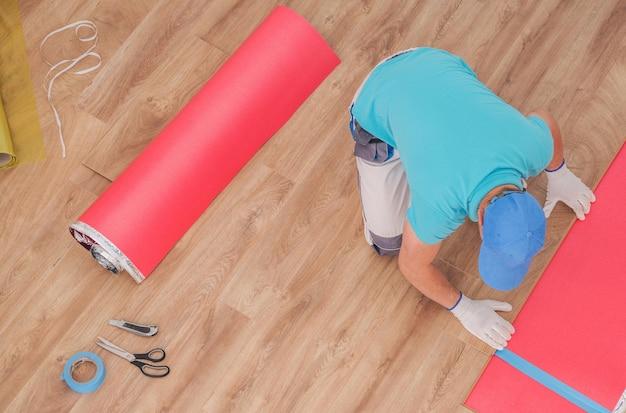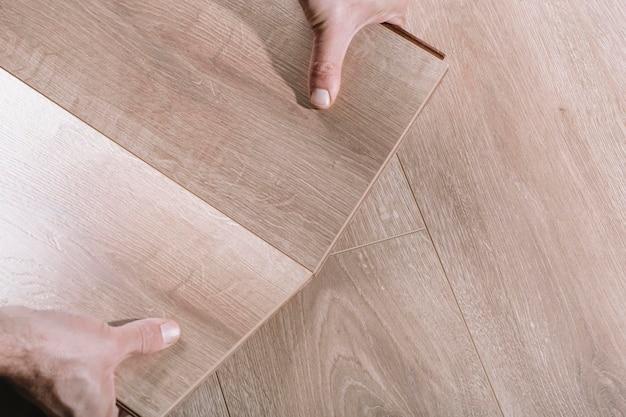Are you considering installing laminate flooring on a concrete subfloor? It’s essential to properly prepare the surface to ensure a successful and long-lasting installation. One crucial aspect of this preparation is installing underlayment between the concrete and laminate flooring. Underlayment helps provide a barrier against moisture, helps with sound insulation, and creates a smooth surface for your laminate flooring.
In this blog post, we’ll guide you through the steps of installing underlayment for laminate flooring on concrete. We’ll cover everything from choosing the right underlayment material to the installation process itself. So, whether you’re a seasoned DIY enthusiast or a novice homeowner looking to tackle this project, we’ve got you covered.
Let’s dive in and get your laminate flooring off to a great start!
How to Easily Install Underlayment for Laminate Flooring on Concrete
Are you ready to transform your space with beautiful laminate flooring? Before you start laying those planks, it’s essential to install a high-quality underlayment for optimal durability, comfort, and noise reduction. In this guide, we’ll walk you through the step-by-step process of installing underlayment for laminate flooring on concrete. Trust us, it’s easier than you think!
Gather Your Materials
First things first, let’s make sure you have everything you need. Here’s a list of materials you’ll need for this project:
- Underlayment: Look for an underlayment specifically designed for laminate flooring. It provides a moisture barrier and soundproofing properties to enhance the lifespan and comfort of your flooring.
- Tape Measure: Measure twice, cut once! A trusty tape measure will be your best friend throughout the installation process.
- Utility Knife: You’ll need a sharp utility knife to trim the underlayment accurately.
- Roller: A roller will help you flatten the underlayment and remove any air pockets that may have formed.
- Duct Tape: Use duct tape to secure the seams of the underlayment together.
- Safety Gear: Don’t forget your safety glasses and gloves to protect yourself during the installation process.
Prepare the Surface
Now that you have your materials ready, it’s time to prepare the concrete surface. Start by thoroughly cleaning the floor and removing any debris or dust that might affect the underlayment’s adhesion. A clean surface ensures a smooth installation and a long-lasting floor.
Roll Out the Underlayment
Unroll your underlayment across the entire floor, leaving a small gap (approximately 1/4 inch) around the edges to allow for expansion. Make sure the underlayment runs parallel to the direction you plan to lay the laminate flooring. Use a utility knife to trim the excess material as needed.
Secure the Seams
Once the underlayment is in place, it’s time to secure the seams. Overlap the edges of the underlayment by a few inches and use duct tape to hold them together. This step ensures a seamless barrier against moisture and provides additional stability to your flooring.
Smooth it Out
To eliminate any wrinkles or air pockets, use a roller to firmly press down on the underlayment. Start from the center and work your way towards the edges. By doing this, you’ll achieve a flat surface for your laminate flooring installation. Remember, a smooth underlayment helps prevent any irregularities from transferring to the visible surface.
Check for Imperfections
Before you begin installing your laminate flooring, take a moment to inspect the underlayment for any imperfections. Look for bulges, tears, or loose edges that may affect the integrity of your flooring. It’s always better to fix these issues before moving forward.
You’re One Step Closer to Flawless Flooring
Congratulations! You’ve successfully installed the underlayment for your laminate flooring on concrete. Give yourself a pat on the back, grab a well-deserved drink, and get ready for the exciting part – laying down those beautiful laminate planks. Your space is about to receive a stunning upgrade!
Remember, a quality underlayment is crucial for ensuring the longevity and performance of your laminate flooring. By following these simple steps, you’ve set the stage for a flawless installation. So, put on some upbeat music, roll up your sleeves, and let the transformation begin!
Get Ready to Enjoy Your New Laminate Flooring
With the underlayment securely in place, you’re now ready to lay down your laminate flooring and unveil a brand-new look for your space. Enjoy the process of installing each plank, marvel at the transformation, and savor that feeling of accomplishment. Just imagine all the memories you’ll create in this beautiful new setting!
Now that you’re armed with the knowledge of how to install underlayment for laminate flooring on concrete, go forth and tackle this project with confidence. Soon enough, your floors will be the envy of all your friends and neighbors. Happy flooring, and may your space be filled with joy, style, and a whole lot of laughter!
Disclaimer: This blog post is not responsible for any impromptu dance parties that may occur while installing your laminate flooring. Proceed with rhythm at your own risk!
FAQ: How to Install Underlayment for Laminate Flooring on Concrete
Can I use carpet underlay under laminate flooring
No, it is not recommended to use carpet underlay under laminate flooring. While they may seem similar, they serve different purposes. Carpet underlay is designed to provide cushioning and support under carpet, while underlayment for laminate flooring is specifically designed to create a smooth, stable surface for the laminate to be installed on. Using carpet underlay can compromise the integrity of the laminate flooring.
What type of tape should I use to join underlayment
To join underlayment, it is best to use a high-quality moisture-resistant tape, such as a polyethylene or vinyl tape. These tapes are specifically designed to create a secure bond and prevent moisture from seeping through the seams. Make sure to follow the manufacturer’s guidelines when applying the tape for optimum results.
What should I place between laminate and concrete
To prevent moisture from reaching your laminate flooring and protect it from potential damage, it is essential to use a moisture barrier between the laminate and concrete. A moisture barrier, also known as a vapor barrier, can be made of plastic or foam and helps to create a barrier that prevents moisture from seeping into the laminate flooring.
Can I lay underlayment on a concrete floor
Yes, you can lay underlayment on a concrete floor. In fact, it is highly recommended to install underlayment on concrete before laying laminate flooring. The underlayment acts as a cushioning layer and helps to smooth out any minor imperfections in the concrete surface, ensuring a more stable and comfortable laminate floor.
Is underlayment necessary for laminate flooring on concrete
Yes, underlayment is necessary for laminate flooring installed on concrete. Not only does it provide a cushioning effect and improve comfort underfoot, but it also helps to reduce noise and acts as a moisture barrier, protecting the laminate from potential damage caused by moisture seeping through the concrete.
Do I need a damp-proof membrane under laminate flooring
Yes, it is recommended to use a damp-proof membrane under laminate flooring, especially when installing it on concrete. A damp-proof membrane, also known as a DPM, helps to prevent moisture from seeping up through the concrete and into the laminate flooring. This additional layer of protection ensures the longevity of your laminate flooring.
Should I glue underlayment to concrete
No, it is not necessary to glue underlayment to concrete. Instead, underlayment can be installed using a floating method, where it is laid down without being attached to the concrete surface. This method allows for flexibility and ease of installation. Gluing the underlayment to concrete is unnecessary and can make future repairs or replacements more difficult.
How do I attach underlayment to concrete
To attach underlayment to concrete, you can use adhesive strips specifically designed for this purpose. These adhesive strips are applied to the edges of the underlayment, creating a secure bond between the underlayment and the concrete surface. Follow the manufacturer’s instructions for proper application and ensure that the underlayment is securely attached before installing the laminate flooring.
Can I staple laminate underlayment
No, it is not recommended to staple laminate underlayment. Stapling can damage the underlayment and compromise its effectiveness. Instead, use adhesive strips or tape to secure the underlayment to the concrete or follow the manufacturer’s guidelines for proper installation methods.
Does underlayment need to be glued
No, underlayment does not need to be glued. Underlayment is typically installed using a floating method, where it is laid down without being attached to the subfloor. This allows for more flexibility and easier installation. However, adhesive strips or tape can be used to secure the underlayment at the seams for added stability.
Can I install laminate over cracked concrete
It is generally not recommended to install laminate flooring over cracked concrete. The cracks can compromise the integrity and stability of the floor and may lead to future problems. It is important to repair the cracks and ensure a smooth, level surface before installing laminate flooring. Consult a professional if you have concerns about the condition of your concrete floor.
What type of underlayment should I use for laminate flooring on concrete
For laminate flooring on concrete, it is important to use underlayment specifically designed for this purpose. Look for underlayment that is moisture-resistant, provides sound insulation, and has a cushioning effect. Foam or cork underlayment are popular options that offer these qualities and are suitable for laminate flooring on concrete.
What is the best thickness for laminate flooring underlayment
The best thickness for laminate flooring underlayment depends on the specific circumstances and preferences. Generally, underlayment with a thickness of 2mm to 3mm is sufficient for most laminate flooring installations. However, if you require additional sound insulation or have uneven subflooring, you may opt for thicker underlayment.
How thick should underlayment be
Underlayment should have a thickness of at least 2mm to provide adequate cushioning and insulation for laminate flooring. Thicker underlayment, such as 3mm or more, can offer additional benefits, such as sound insulation and support for uneven subfloors. Consider your specific needs and consult the laminate flooring manufacturer’s recommendations for the best thickness.
Do I need to level my concrete floor before installing laminate
Yes, it is crucial to level your concrete floor before installing laminate flooring. Concrete floors can have slight variations, and any unevenness can cause problems with the laminate installation. Leveling the floor ensures a smooth and stable surface for the laminate flooring, preventing issues such as joint separation or uneven wear.
What should I use under laminate flooring in a basement
In a basement, it is important to use underlayment that provides moisture protection, as basements tend to have higher humidity levels. Look for underlayment that has a built-in moisture barrier or use a separate damp-proof membrane to prevent moisture seepage. Additionally, consider using underlayment with sound insulation properties to minimize noise transmission in the basement area.
Can I glue down laminate flooring to concrete
Yes, you can glue down laminate flooring to concrete. Gluing down laminate flooring provides additional stability and may be necessary in certain circumstances, such as when installing in high-traffic areas or if the concrete subfloor has significant imperfections. However, gluing down laminate flooring is not a common practice and should be done according to the manufacturer’s recommendations and with the use of specific adhesives designed for this purpose.
What is liquid DPM
Liquid DPM stands for liquid damp-proof membrane. It is a type of moisture barrier that is applied as a liquid coating directly onto the concrete subfloor. Liquid DPM forms a waterproof layer that prevents moisture from seeping through the concrete and damaging the laminate flooring. It is an alternative to using separate sheets of DPM and may be suitable for certain types of concrete surfaces.

